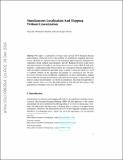Analytical SLAM without linearization
Author(s)
Tan, Feng; Lohmiller, Winfried; Slotine, Jean-Jacques E
Download1512.08829.pdf (3.057Mb)
Terms of use
Metadata
Show full item recordAbstract
© 2017, © The Author(s) 2017. This paper solves the classical problem of simultaneous localization and mapping (SLAM) in a fashion that avoids linearized approximations altogether. Based on the creation of virtual synthetic measurements, the algorithm uses a linear time-varying Kalman observer, bypassing errors and approximations brought by the linearization process in traditional extended Kalman filtering SLAM. Convergence rates of the algorithm are established using contraction analysis. Different combinations of sensor information can be exploited, such as bearing measurements, range measurements, optical flow, or time-to-contact. SLAM-DUNK, a more advanced version of the algorithm in global coordinates, exploits the conditional independence property of the SLAM problem, decoupling the covariance matrices between different landmarks and reducing computational complexity to O(n). As illustrated in simulations, the proposed algorithm can solve SLAM problems in both 2D and 3D scenarios with guaranteed convergence rates in a full nonlinear context.
Date issued
2017Department
Massachusetts Institute of Technology. Department of Mechanical Engineering; Massachusetts Institute of Technology. Department of Brain and Cognitive Sciences; Massachusetts Institute of Technology. Nonlinear Systems LaboratoryJournal
International Journal of Robotics Research
Publisher
SAGE Publications
Citation
Tan, Feng, Winfried Lohmiller, and Jean-Jacques Slotine. “Analytical SLAM Without Linearization.” The International Journal of Robotics Research 36, no. 13–14 (June 13, 2017): 1554–1578. doi:10.1177/0278364917710541.
Version: Original manuscript
ISSN
0278-3649
1741-3176
Collections
The following license files are associated with this item: